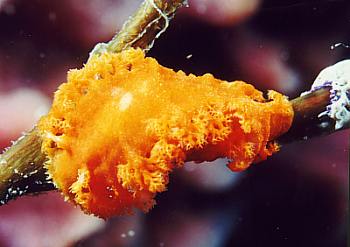
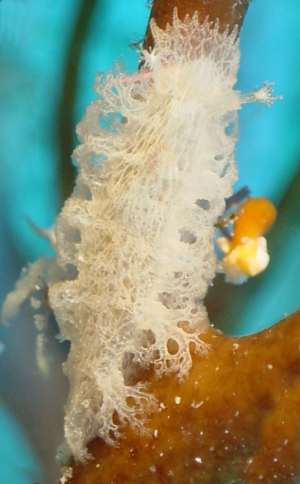
Tritoniopsis frydis
Marcus & Marcus 1970
Order: NUDIBRANCHIA
Suborder: DENDRONOTINA
Family: Tritoniidae
DISTRIBUTION
Caribbean
PHOTO
Upper: off Delray Beach, Florida, Depth approx 60 feet. Approx 1 inch long. Photo: Linda Ianniello.
Lower: Bimini Islands, Bahamas, Western Atlantic, Depth: 16.5m., February 09, 2004. Length: 13mm. Photo: Marina Poddubetskaia
Ranges in colour from translucent white to orange, feeds on gorgonian Plexaurella and grows to approx 4cm (Humann, 1992).
Is very similar to the Indo-West Pacific species Tritoniopsis elegans
Reference:
• Marcus, Er. & Marcus, Ev (1970) Opisthobranchs from Curacao and faunistically related regions. Studies on the Fauna of Curacao and other Caribbean Islands, 33: 1-129.
• Marcus, Ev (1983) The Western Atlantic Tritoniidae. Bolm. Zool., Univ. Sao Paulo, 6: 177-214.
Rudman, W.B., 2001 (January 6) Tritoniopsis frydis Marcus & Marcus 1970. [In] Sea Slug Forum. Australian Museum, Sydney. Available from http://www.seaslugforum.net/find/tritfryd
Related messages
Tritoniopsis frydis in aquarium
March 20, 2008
From: Emily Hetrick
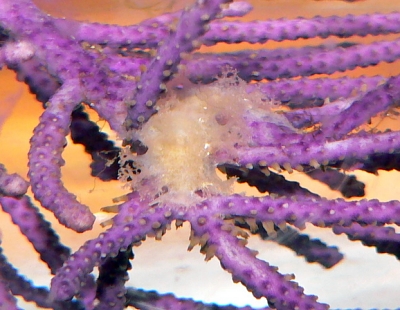
I am interested in knowing whether or not this sea slug is Tritoniopsis frydis. I found it in my aquarium on one of my gorgonians. The aquarium is set up in part to be a haven for Caribbean Elysia spp. and includes three gorgonians (two of which I know were collected from Florida waters) as well as macroalgaes that were collected at the same time as the coral. Although I purchased these items several months ago, I can only assume that the hitchhiking sea slug smuggled its way into my aquarium via either the coral or the algae.
Two of the gorgonians in the tank I feel reasonably certain are of the genus Pterogorgia. I am not as confident of my identification of the gorgonian that I found this sea slug on, however I believe it is a Pseudopterogorgia spp. I am not sure if I have the gorgonians that this slug is believed to feed on, but it must be eating as it has survived for several months.
Length: 1.5 cm approx.. Photographer: E. Hetrick.
Thank you for your assistance.
Emily Hetrick
emjhet@yahoo.com
Hetrick, E., 2008 (Mar 20) Tritoniopsis frydis in aquarium. [Message in] Sea Slug Forum. Australian Museum, Sydney. Available from http://www.seaslugforum.net/find/21135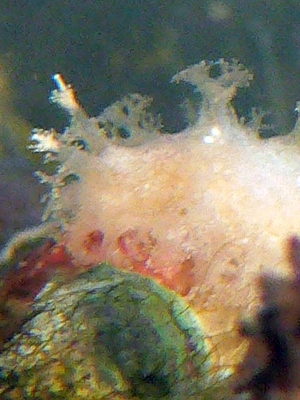
Dear Emily,
It certainly looks like Tritonopsis frydis, which on the available evidence, seems to feed on a variety of Caribbean gorgonians.
This diet certainly separates it from the very similar looking Indo-West Pacific species Tritoniopsis elegans which feeds on solid unbranching soft corals such as Lobophyton. T. elegans is often found uninivited in aquaria as it hitches a ride, as a tint juvenile, on soft coral colonies.
Best wishes,
Bill Rudman
Tritoniopsis frydis from Grenada
November 2, 2007
From: Jim Anderson
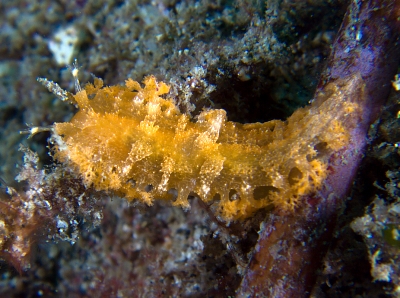
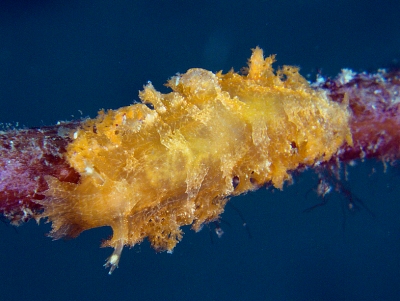
Dear Bill,
We were diving recently in Grenada and our guide, Paul Ward, found a small group of these animals. They were congregated on a dead branch covered in sponges etc. lying on the bottom among small corals and sponges. There were 5 that we could see, 2 with spawn - but those images were not in focus I'm afraid. Sea temperature 28 deg C.
Locality: Flamingo Bay, 15 m, Grenada, Caribbean Sea, 19 October 2007, debris among coral, sand and sponge growth. Length: 35 mm. Photographer: Jim Anderson.
Kind regards.
Jim Anderson
jander4454@gmail.com
Anderson, J, 2007 (Nov 2) Tritoniopsis frydis from Grenada. [Message in] Sea Slug Forum. Australian Museum, Sydney. Available from http://www.seaslugforum.net/find/21051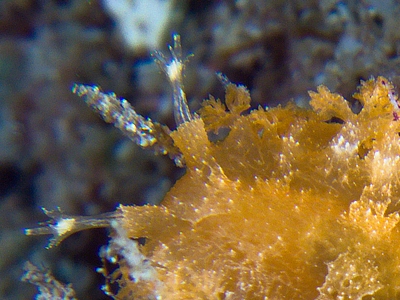
Dear Jim,
I guess species like this which are quite tightly tied to their food are not well adapted to dealing with catastrophes like their food source dying. Sponge-feeding dorids, or at least those that have been studies, seemed to be able to find their sponge food by using their rhinophores to 'smell' sponge chemicals in the water. It would be interesting to know whether aeolids or tritoniids, which are tied to particular cnidarians, have the same ability as adults. Certainly their free-swiming larvae have no trouble finding their food organism, so it would be interesting to know if that is the first and last chance they have of finding a colony that will last them until they produce the next generation.
Best wishes,
Bill Rudman
Tritoniopsis frydis from West Indies
June 22, 2007
From: Jim Chambers
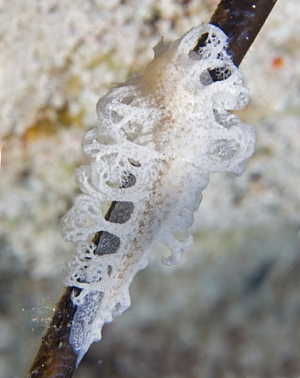
G'Day, Bill.
While diving on Little Cayman, British West Indies (Caribbean Sea) in May 2007, I saw a Tritoniopsis frydis on a gorgonian at the dive site Mixing Bowl at a depth of about 12 meters. At the time I saw it, it was just moving off a mass of eggs, which I assume were just laid. A few days later I saw another one (lower photo ) on the same gorgonian, but the eggs were gone, presumably hatched.
Cheers,
Jim Chambers
Georgia, USA
jimbo1946@mindspring.com
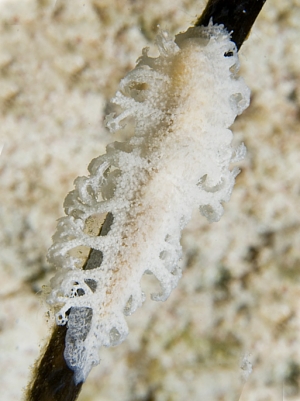
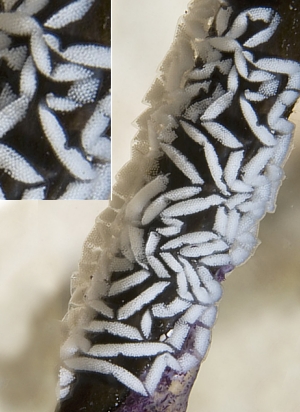
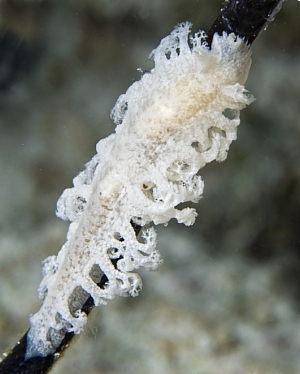
Thanks Jim,
It's interesting to get some more photos of this Caribbean equivalent to the Indo-West Pacific species T. elegans. One major differnce though is that your species feeds on gorgonians while the Indo-West Pacific species feeds on leathery soft corals such as Lobophyton.
Best wishes,
Bill Rudman
Tritoniopsis frydis from Cayman Islands, Caribbean Sea
May 25, 2005
From: Rod Dickson
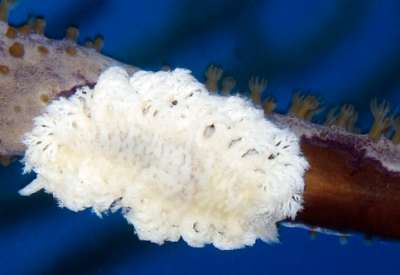
Hi Dr Bill,
My sister, Kathryn Dickson sent in a photo of an orange Tritoniopsis frydis from Little Cayman a few months ago [message #12941 ]. I found this one-inch white specimen recently at a depth of 40 feet at Gay's Reef on the south side of LC, munching away on a gorgonian. Just thought you might be interested in the local colour variations here off of our little rock.
Locality: Little Cayman, Cayman Islands, Caribbean Sea. Depth: 12 m. Length: 1 inch.10 May 2005. patch reef. Photographer: Rod Dickson
Rod Dickson
chillin@candw.ky
Dickson, R., 2005 (May 25) Tritoniopsis frydis from Cayman Islands, Caribbean Sea. [Message in] Sea Slug Forum. Australian Museum, Sydney. Available from http://www.seaslugforum.net/find/13826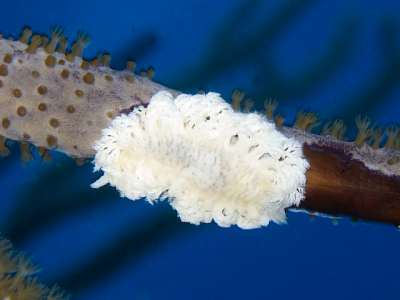
Dear Rod,
Thanks very much for continung the story. The photo clearly shows how this nudibranch scrapes the animal tissue off the skeleton of the gorgonian colony.
Best wishes,
Bill Rudman
Tritoniopsis frydis from Little Cayman Island
January 29, 2005
From: Kathryn Dickson
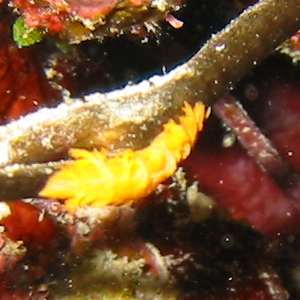
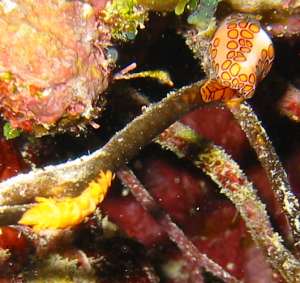
Hello Dr. Rudman -
This very orange tiny nudibranch was seen while diving off the south shore of Little Cayman Island in early December 2004. We were not able to find any creature resembling it in Humann's guide, or on looking through the photos posted on the sea slug forum. It was brilliantly orange with no other markings. Unfortunately the photo is somewhat out of focus. We would be grateful if you could identify it for us.
Locality: Southern Shore, Little Cayman Island, British Cayman Islands, Caribbean Sea. Depth: 25 feet. Length: 1 inch. early December 2004, on healthy coral reef. Photographer: Kathryn Dickson
Thanks! I love the Sea Slug Forum!
Kathy Dickson
Kathy.Dickson@ec.gc.ca
Dickson, Kathryn M., 2005 (Jan 29) Tritoniopsis frydis from Little Cayman Island. [Message in] Sea Slug Forum. Australian Museum, Sydney. Available from http://www.seaslugforum.net/find/12941Dear Kathy,
I am pretty sure this is the yellow colour form of Tritoniopsis frydis. Have a look at Linda Ianniello's message [#7981]. The Flamingo tongue ovulid, Cyphoma gibbosum, in the top right of your lower photo, is a good clue. It feeds on gorgonians, as does Tritoniopsis, so its a pretty good indicator that the yellow 'slug' is a gorgonian feeder as well. What I don't know is whether the two species will eat a range of gorgonians or whether they are specialist feeders.
Best wishes,
Bill Rudman
Tritoniopsis frydis: 2 colour forms from Bahamas
March 9, 2004
From: Marina Poddubetskaia
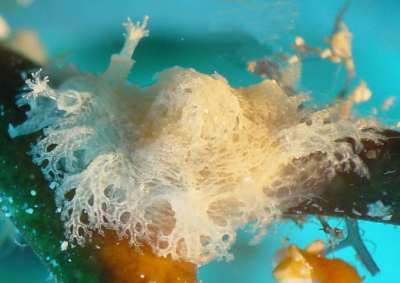
Dear Bill,
I was happy to find in Northern Bahamas a gorgonian with one orange and one white Tritoniopsis frydis near an egg-mass (see my next message [#12337]). A great find ! It was the first time I saw this species, so I'm happy to share my observations with you.
Date: February 09, 2004
Location: Bimini Islands, Bahamas, Western Atlantic
Site: Rainbow Valley
Depth: 16.5m
Size: orange - 15mm / white - 13mm
Photos: Marina Poddubetskaia - Nembro website
Cordially,
Marina.
nembro@nembro.info

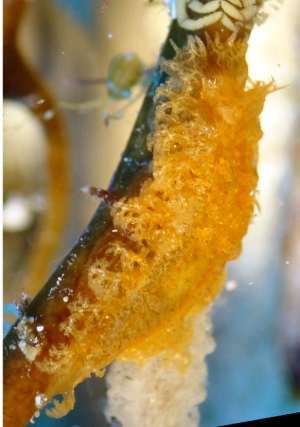
Thanks Marina,
It is a nice find
Best wishes
Bill Rudman
Tritoniopsis frydis: egg-ribbon
March 9, 2004
From: Marina Poddubetskaia
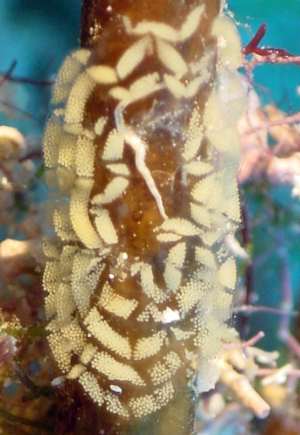
Dear Bill,
To accompany my previous message [#12336] on Tritoniopsis frydis, here are some photos of the eggs. I'm convinced they belong to this species. Egg-ribbon is 10mm in size and all other data are the same than in previous message. Please, also note some eggs near the white specimen (in the previous message too).
Photos: Marina Poddubetskaia - Nembro website
Best wishes,
Marina.
nembro@nembro.info
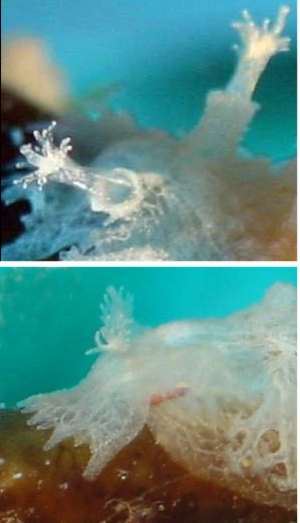
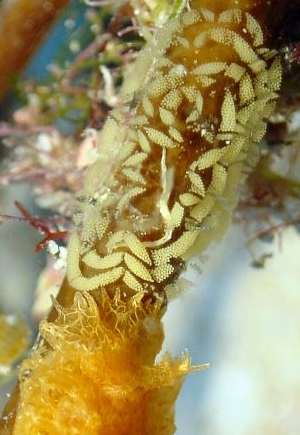
Thanks Marina,
These certainly look like tritoniid eggs and match the type of egg ribbon we already have on the Forum for aquarium animals. However there is another message today [#12411] which seems to be of this species, but its eggs are wrapped around the gorgonian 'stalk'. I guess we will have to wait for more information
Best wishes
Bill Rudman
Tritoniopsis frydis in aquaria
March 9, 2004
From: Evan Warren
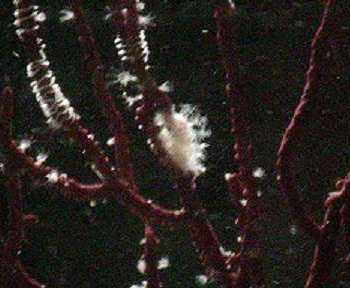
I recently purchased a red gorgonian that came from the northern Caribbean.It has about 8 nudibranches on it that I believe are Tritonia festiva from personal observation by comparing markings and the egg mass. I was wondering if they are toxic to tankmates if they die or are are bothered. I also want to know if there is any way to keep them alive without feeding them soft corals. Can they survive on algae, Caulerpa, plants? I'm not sure what to do with them if I can't keep them alive but I'm going to remove them from the gorgonia tonight. Maybe if someone is interested in studying them for scientific research I could send them on if the shipping isn't outrageous or they are willing to put up shipping. Anyway can you tell me if my observations are correct from the photos. Sorry I couldn't get better pics but they dont make a macro lens for my camera and for some reason they came out a little dark. I also included a pic of the gorgonia.
Evan Warren
Light7@fuse.net
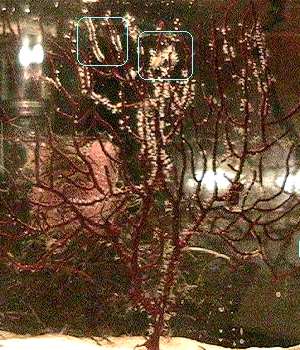
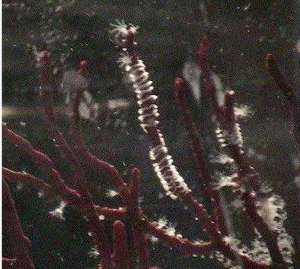
Dear Evan,
Your animal is a definitely a tritoniid, but T. festiva is a north Pacific species. Your animal is probably the Caribbean species Tritoniopsis frydis. I am posting another message on that species today [#12336] so have a look there for more information. On reason I am not sure is the way the egg ribbons are coiled around the gorgonian. All other photos I have seen of this species show the egg ribbons forming a planar coil on a flat or relatively flat surface. Some tritoniids do lay an egg ribbon wrapped around a stalk like yours does so your animal could be another species or Tritoniopsis frydis could do both.
Concerning keeping them in your aquarium. This species is intimately associated with the gorgonian they arrived on. They live on it, feed on it, and lay their eggs on it. They will no more eat plant material than your pet dog or cat will! So I guess that leaves you, and the slugs, with a predicament. They will certainly eat your gorgonian, so what you have to decide is whether having these beautiful nudibranchs in your tank is better than keeping a boring colony of gorgonians?
Best wishes
Bill Rudman
Tritoniopsis frydis in aquarium
February 5, 2004
From: Troy M.
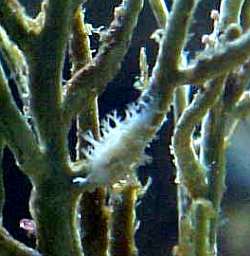
Dear Bill,
I was hoping to determine what species I have and whether it is beneficial or detrimental to my tank. I noticed them about 2 weeks after adding some gorgonians from an online retailer. I am in the process of contacting him now to find out where they are from. He is in south Florida. I have only seen them on the Green Sea Whip gorgonian I have. Two have ventured out onto the glass, and one of those made it back to the gorg. The other is missing at this time. It doesn't appear that they are eating the gorg, nor did they do a good job of eating the red slime algae that was on it briefly. Also, I noticed while one of them was on the glass, a small spiral of what appeared to be eggs just behind the slug. The next morning, the slug and eggs were gone.
Troy M.
djxtreme@iname.com
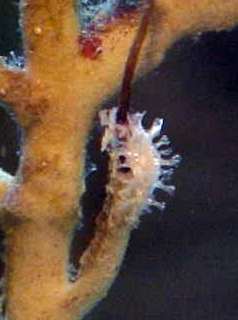
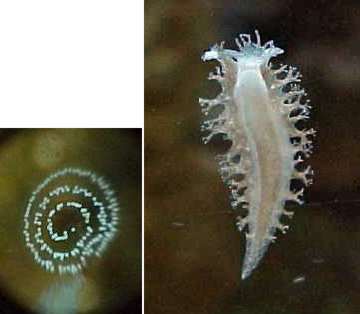
Dear Troy,
If it is from the Caribbean and is associated with a gorgonian, then I suspect it is Tritoniopsis frydis. If it was from the tropical Indo-West Pacific it would most probably be Tritoniopsis elegans, but that species feeds on soft corals rather than gorgonians.
Best wishes
Bill Rudman
Tritoniopsis frydis from Florida
September 23, 2002
From: Linda Ianniello

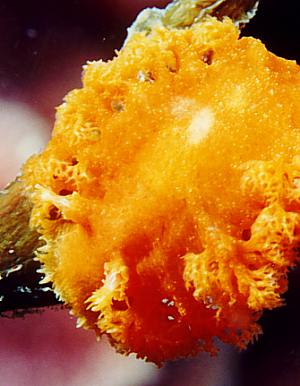
Dr. Bill,
attached is a shot of Tritoniopsis frydis from Florida. It was found at night, off Delray Beach, Florida, at a depth of about 60 feet. It was about 1 inch long.
Regards,
Linda I.
linda1@us.ibm.com
Ianniello, L., 2002 (Sep 23) Tritoniopsis frydis from Florida. [Message in] Sea Slug Forum. Australian Museum, Sydney. Available from http://www.seaslugforum.net/find/7981Thanks Linda,
In this photo it looks like the slug has eaten all the tissue off the skeletal core of this soft coral colony, which I guess is Plexaurella sp, which it is reported to feed on. I have included a close-up of the head to show some of the texture of the dorsal skin, and to show the relatively small rhinophores.
Best wishes,
Bill Rudman
Tritoniopsis frydis from Colombia
June 1, 2001
From: Elianny Domínguez
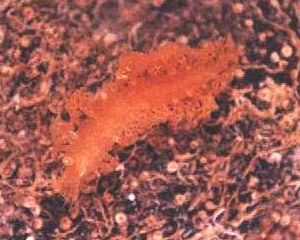
Dear Bill,
I believe this might be Tritonia incerta. We found 12 of this animals here in the coast of the Tayrona National Park on soft coral in the area surrounding Punta Aguja island, which is close to the shore, Santa Marta, Colombia (Caribbean coast) at a depth of 30ft, laying eggs masses (circular forms of pale yellow and orange color) on a soft coral.
This one is bright orange but a few of them had a very pale brown color (we call it khaki or kaqui color).
Cheers,
Elianny Domínguez.
elicelotte@latinmail.com
Domínguez, E., 2001 (Jun 1) Tritoniopsis frydis from Colombia. [Message in] Sea Slug Forum. Australian Museum, Sydney. Available from http://www.seaslugforum.net/find/4421Dear Elianny,
This is certainly a tritoniid but I think it is probably Tritoniopsis frydis which seems to be the Caribbean cousin of the Indo-West Pacific Tritoniopsis elegans. Both are quite variable in colour.
Best wishes,
Bill Rudman
Bahamas slugs
January 31, 2001
From: Marli Wakeling
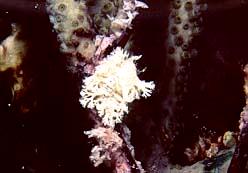
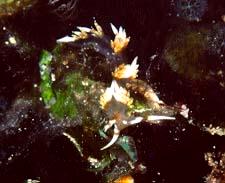
Hi Bill,
Here are two photos from the Turks and Caicos Islands, near the Bahamas, where it is next to impossible to find nudibranchs! I found only three different ones over 24 dives this summer. One is Tritoniopsis frydis. The photo also shows a very strange green shrimp. I have no idea what it could be, and the other is an undescribed Facelina sp. Both were found in shallow water( 30 feet) at night.
Marli
scubamarli@excite.com
Wakeling, M., 2001 (Jan 31) Bahamas slugs. [Message in] Sea Slug Forum. Australian Museum, Sydney. Available from http://www.seaslugforum.net/find/3315Thanks Marli,
Bill Rudman
